All temples in Luxor and Aswan from Safaga Port
Luxor is renowned as the ‘World’s Greatest Open-Air Museum,’ offering an unparalleled glimpse into the splendor of ancient Egyptian civilization.
As you explore this historic city, you’ll be captivated by the grandeur of Karnak Temple, an expansive complex whose construction spanned several centuries. The temple’s towering columns, adorned with detailed hieroglyphs and imposing statues, evoke a sense of awe and reverence.
Equally impressive is Luxor Temple, a masterpiece of ancient architecture renowned for its majestic pylons and serene sacred lake, which reflect the temple’s historical and spiritual significance. For a truly extraordinary experience, make your way to Hatshepsut’s Temple at Deir el-Bahari. This architectural marvel is carved into the sheer cliffs of the valley, providing stunning panoramic views that enhance its dramatic presence.
Each site in Luxor offers a unique window into the past, allowing visitors to fully immerse themselves in the rich tapestry of Egypt’s ancient heritage.
Aswan
Aswan presents a unique and enchanting allure, distinct from other Egyptian destinations. A visit to the Temple of Philae, now relocated to Agilkia Island, is an essential experience. This temple is celebrated for its graceful columns and meticulously detailed carvings, which showcase the artistry and devotion of its builders.
A bit farther afield lies Abu Simbel, an extraordinary site renowned for its immense statues of Ramses II. These monumental figures, carved directly into the rock, exude power and grandeur, making Abu Simbel an unmissable highlight of any trip to Egypt.
Additionally, the Temple of Kom Ombo offers a fascinating visit with its dual dedication to the gods Horus and Sobek. This unique temple, beautifully situated on the banks of the Nile, features a symmetrical design and intriguing reliefs that honor both deities. Each of these sites contributes to the rich tapestry of Aswan’s historical and cultural heritage, making the region a captivating destination for exploration.
A Temple Tour of Luxor and Aswan
Luxor
Luxor, often referred to as the “World’s Greatest Open-Air Museum,” is a treasure trove of ancient Egyptian temples.
1-Karnak Temple
Karnak Temple stands as one of the grandest religious sites ever constructed, dedicated to the mighty god Amun-Ra. This immense complex, known for its monumental scale, features towering pylons that lead to the majestic hypostyle hall—a vast expanse filled with a dense forest of intricately carved columns. The site also boasts a serene sacred lake, adding to its grandeur and spiritual ambiance.
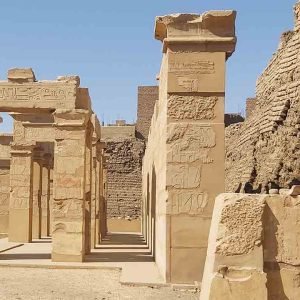
Historically, Karnak Temple was believed to be the very site where creation commenced, serving as a divine connection point between the god Amun-Ra and the ancient Egyptians. Its significance extends beyond its architectural splendor; it was a central place of worship and a repository of invaluable insights into ancient Egyptian religion and culture. The temple’s elaborate decorations and inscriptions provide a profound glimpse into the spiritual and ceremonial practices of one of history’s greatest civilizations.
2-Luxor Temple
Luxor Temple, originally linked to Karnak Temple by a grand, sphinx-lined avenue, is a breathtaking example of ancient Egyptian religious architecture. Dedicated to the powerful deities Amun-Ra and his wife Mut, the temple is renowned for its awe-inspiring features, including towering pylons, a majestic obelisk, and beautifully preserved colonnades. Each of these elements contributes to the temple’s impressive and majestic atmosphere, making it an essential destination for anyone exploring Luxor.
Historically known as Ipet-resyt, or the “Southern Sanctuary,” Luxor Temple is located about three kilometers south of the Karnak Temple complex. This temple was a focal point for the Opet Festival, a major religious celebration in ancient Egypt, which honored the gods and rejuvenated the divine kingship.
The construction of Luxor Temple was a collaborative effort among several prominent pharaohs, including Hatshepsut, Amenhotep III, Tutankhamun, Horemheb, and Ramesses II. Each ruler added their unique contributions, resulting in a temple that stands as a monument to Egypt’s rich religious and cultural history.
The elaborate carvings and majestic scale of Luxor Temple offer a fascinating window into the ancient world, revealing the grandeur and depth of Egyptian civilization.
3-Temple of Hatshepsut
Located at Deir el-Bahari, this temple is a masterpiece of architecture, carved into the cliffs with terraces and colonnades. It was dedicated to the female pharaoh Hatshepsut and is a testament to her power and influence.
Hatshepsut (c.1473-1458 BC) constructed a magnificent temple in Deir al-Bahari, across the Nile from Karnak Temple. Senenmut designed the temple, known as Djeser-djeseru, or “the Holy of Holies.”The upper level includes an open courtyard with mummiform statues of Hatshepsut as Osiris. The temple is Hatshepsut’s mortuary temple, but it also has sections dedicated to her father Thutmose I, the goddess Hathor, and the funerary god Anubis.
4-Medinet Habu
Medinet Habu is an impressive ancient Egyptian temple complex located on the west bank of the Nile, close to Luxor. Renowned for its remarkable state of preservation, this site dates back to the New Kingdom period, offering a glimpse into the architectural and artistic achievements of ancient Egypt.
The centerpiece of Medinet Habu is the Mortuary Temple of Ramesses III, a grand structure celebrated for its intricate carvings, monumental statues, and detailed reliefs. The temple stands as a testament to the grandeur and religious significance of the era, showcasing the artistic prowess and ceremonial practices of the time.
- Mortuary Temple of Ramesses III:
-The grand temple was built by Pharaoh Ramesses III, who ruled from 1186 to 1155 BC. It’s dedicated to Amun, the king of the gods, and also served as a mortuary temple for the pharaoh. The walls are adorned with detailed reliefs and inscriptions depicting the pharaoh’s military victories, religious rituals, and offerings to the gods, including battles against the Sea Peoples and other foreign invaders.
- Chapel of Amun and Other Shrines:
– In addition to the main temple, the complex includes a small temple dedicated to Amun, built by Hatshepsut and Thutmose III. There are also shrines dedicated to various deities and royal ancestors.
5-The Ramesseum
The Ramesseum is a very old and big temple. It was built for a famous king of Egypt named Ramses II. Even though it is broken in many parts, it is still very cool to see.
There used to be a really big statue of King Ramses II there, but now it’s in pieces. You can still see some of it. The temple also has a big room with tall pillars, but it is damaged. There are lots of pictures and writing on the walls that tell stories about the king and the gods.
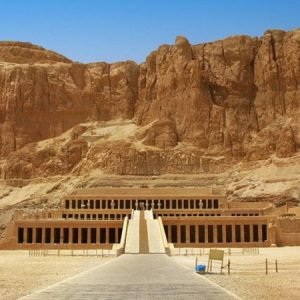
is not as pretty as other temples, it is still very important because it shows us how powerful King Ramses II was.
6-The Colossi of Memnon: Two Giant Statues
The Colossi of Memnon are two incredibly big statues of a powerful Egyptian king named Amenhotep III. They are sitting down and look very impressive.
These statues are all that’s left of a huge temple. You can see the statues from far away, and they look even bigger when you get close. They are made of special stones and are very heavy.
People used to say that one of the statues made a sound like a person singing in the morning. This is not true anymore, but it’s still a famous story.
Visiting the Colossi of Memnon is like stepping back in time and imagining how amazing the whole temple must have looked.
Aswan
Aswan, with its serene Nile setting, offers a different kind of temple experience.
1-Temple of Philae
The Temple of Philae, located on Agilkia Island, is renowned for its impressive monuments from the Ptolemaic period, including the famous Temple of Isis. This temple was a significant center of worship until the Byzantine Emperor Justinian I decreed the closure of pagan temples in the early 6th century.
In addition to the Isis temple, the site also features a temple dedicated to the goddess Hathor and the Kiosk of Trajan. These historical structures were meticulously relocated to Agilkia Island during the 1960s as part of the UNESCO Nubia Campaign, which aimed to preserve them from the flooding caused by the construction of the Aswan High Dam.
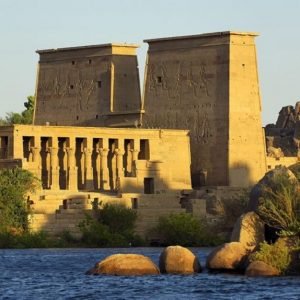
This relocation ensured that these ancient treasures could continue to be appreciated despite the challenges posed by modern developments..
2-Temple of Kom Ombo
The site is named after the Arabic term “kum” meaning “mound” and “Ombo,” derived from the ancient Egyptian “Nubt,” interpreted as “the golden city.” The temple honors two deities: the crocodile god Sobek and the falcon god Har wer. It was constructed during the Greco-Roman period and features two parallel axial passages that lead to sanctuaries for each deity. The temple has stunning column capitals and intriguing wall decorations, including a Roman Period carving of surgical instruments. Visitors are struck by the symbolic scenes of Sobek and Harwer at the temple’s back.
3-Abu Simbel Temple
Abu Simbel stands as a testament to ancient Egyptian engineering and artistry. Carved into the towering sandstone cliffs on the western bank of Lake Nasser, this UNESCO World Heritage site is home to two colossal temples: the Great Temple of Ramses II and the smaller Temple of Hathor and Nefertari.
The Great Temple of Ramses II is a breathtaking spectacle. Four colossal statues of the pharaoh dominate the entrance, their sheer size and intricate detail leaving visitors in awe. Inside, the temple boasts a series of chambers adorned with intricate reliefs depicting the pharaoh’s military victories and religious beliefs. A truly magical experience awaits those who visit on February 21st or October 21st, when the sun’s rays illuminate the innermost sanctuary in a celestial alignment.
Dedicated to the goddess Hathor and Queen Nefertari, Ramses II’s beloved wife, the smaller temple is equally impressive. Its interior is adorned with exquisite reliefs and paintings, showcasing the artistry and craftsmanship of the ancient Egyptians.
4-Edfu Temple
Edfu Temple is renowned as one of the most magnificent and best-preserved monuments of ancient Egypt. Dedicated to Horus, the falcon god, this architectural marvel showcases the exceptional craftsmanship and artistry of its creators.
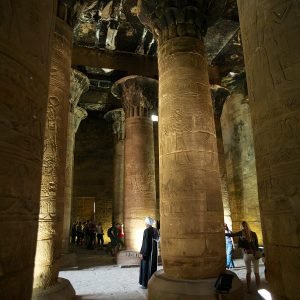
Upon entering the temple, visitors are greeted by the awe-inspiring hypostyle hall, a vast space dominated by a forest of colossal columns that reaches towards the sky, creating a dramatic and imposing atmosphere. The walls of the temple are richly decorated with intricate hieroglyphs and detailed carvings, which vividly illustrate ancient Egyptian mythology, religious rituals, and aspects of daily life.
One of the temple’s most striking features is the mammisi, a dedicated structure celebrating the divine birth of Horus, which adds another layer of significance and splendor to the site. A visit to Edfu Temple offers a profound journey into the past, allowing visitors to immerse themselves in the grandeur and spiritual richness of ancient Egyptian civilization.
5-Kalabsha Temple
The Temple of Kalabsha stands as a remarkable testament to ancient Egyptian architectural brilliance. Originally constructed in Nubia, this impressive temple was meticulously relocated to its present site to safeguard it from the encroaching waters of the Nile River. The temple is renowned for its grand entrance, or pylon, which is adorned with elaborate carvings that capture the essence of ancient artistry.
As you step inside, the vast hall with its towering columns creates a breathtaking and awe-inspiring atmosphere, showcasing the grandeur of the temple’s design. The inner sanctuary, dedicated to sacred rituals, further highlights the temple’s religious significance and its role in ancient ceremonies.
Additionally, visitors can explore the Kiosk of Queen Hatshepsut, a smaller yet equally striking structure, adding another layer of historical and architectural interest to the site. The Temple of Kalabsha offers a captivating glimpse into the ancient world, combining artistic splendor with historical depth.
6-Wadi es-Sebua
Wadi es-Sebua is home to an exceptionally well-preserved temple complex that offers visitors a fascinating insight into the lives of ancient Egyptians. Set against the tranquil backdrop of Lake Nasser, this remarkable site features stunning sandstone architecture that captivates the eye.
As you approach the temple, you’ll be greeted by towering pylons adorned with impressive statues of Ramses II, each detail meticulously crafted to showcase the pharaoh’s grandeur. The walls of the temple are lavishly decorated with intricate carvings that vividly narrate tales of Ramses II’s military victories and deeply held religious beliefs, immersing you in the rich history and culture of the time.
Exploring Wadi es-Sebua allows you to experience the magnificence of ancient Egypt in a largely untouched environment. The serenity of the location enhances the experience, making it a perfect setting for reflection and appreciation of this remarkable civilization’s achievements. A visit here is not just a journey through history; it is an opportunity to connect with the legacy of one of the world’s most fascinating cultures.
The temples of Aswan and Luxor collectively embody the grandeur and spiritual richness of ancient Egyptian civilization, offering visitors a profound journey through history. In Luxor, the colossal Karnak Temple and the majestic Luxor Temple stand as monumental testaments to the architectural and religious achievements of the ancient Egyptians. Karnak’s sprawling complex and Luxor’s stunning pylons and obelisks highlight the city’s historical significance as a major religious center.
In Aswan, the awe-inspiring Temple of Philae, relocated to Agilkia Island, continues to captivate with its elegant columns and intricate carvings. The nearby Abu Simbel, with its colossal statues of Ramses II, provides a dramatic insight into the power and artistry of ancient Egypt. The Temple of Kom Ombo, dedicated to the gods Horus and Sobek, adds to the region’s diverse array of sacred sites.
Together, these temples not only showcase the architectural prowess of their builders but also offer a glimpse into the spiritual and cultural practices of ancient Egypt. Each site, with its unique features and historical significance, contributes to a richer understanding of Egypt’s storied past, making a visit to these temples a truly unforgettable experience

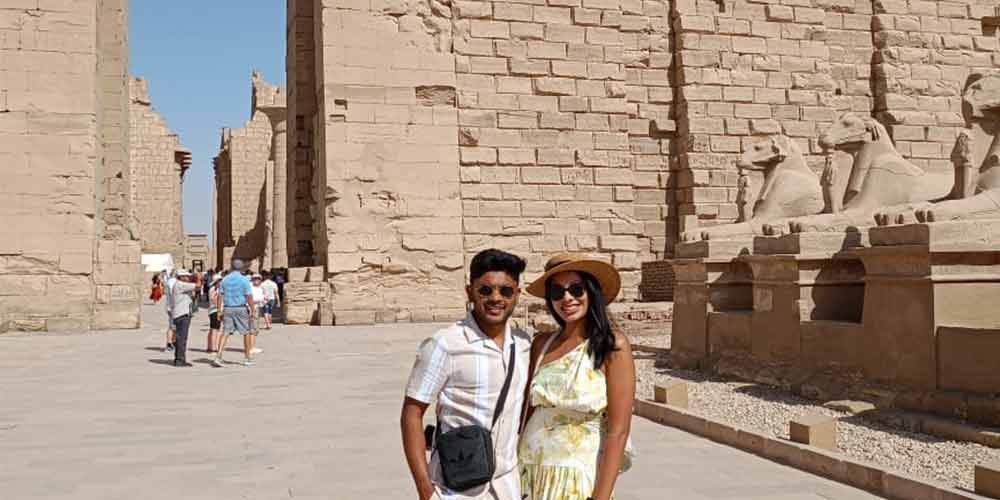
Comment (0)